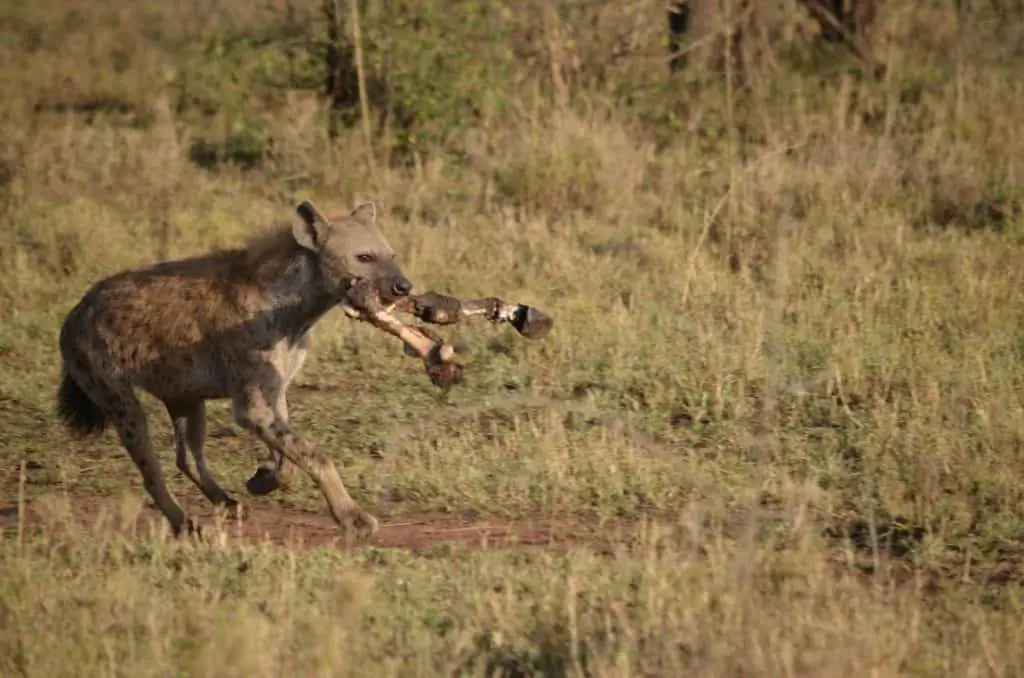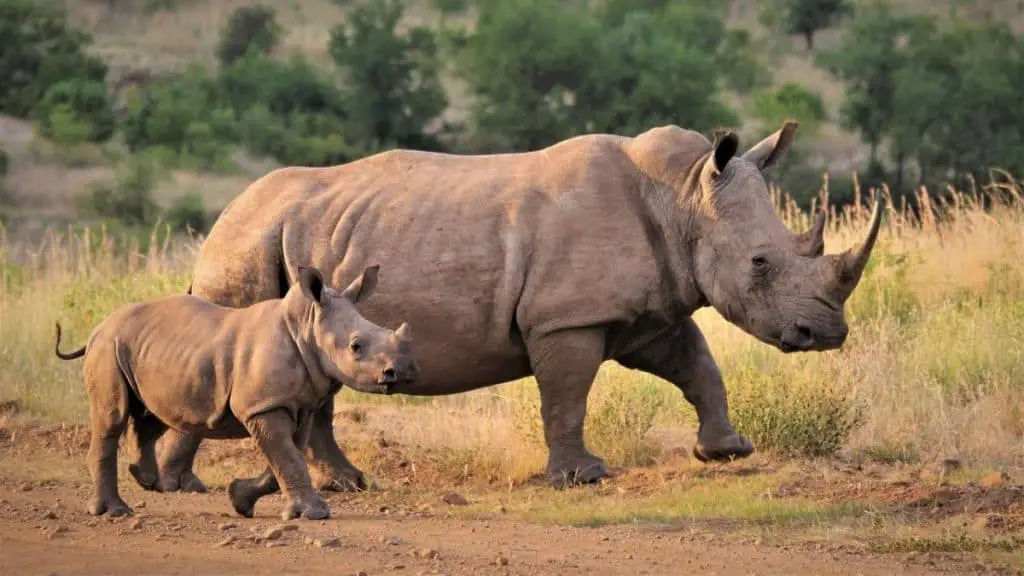When I was a child, I watched a nature documentary where a lion attacked an elephant calf, stretching its skin to unimaginable lengths to take it down. Luckily for the 8-year-old me, the elephant got away when its mum came to protect it.
Elephants don’t have many predators, but lions are their most dangerous. Two male lions can take down a sub-adult male. Hyenas will typically only prey on sick or dying calves, while wild dogs use their numbers to overwhelm small elephants. Snakes such as the cobra or black mamba can cause fatal bites in calves, while crocodiles can be dangerous at a waterhole.
I have learned a lot about animals since I watched the documentary with the elephant, and elephants have always been one of my favourite animals. Let’s look at how they protect themselves from any predators they may have.
Do you know how elephants mate? Find out here

How do elephants protect themselves?
Elephants are enormous animals, and this is their primary defence against other animals. Elephants can grow up to 4 meters tall and early 6,500 kg. There are not many animals that could take down a fully grown adult.
Elephants can also run fast for their size, an excellent defence against some animals. Elephants can run up to 40 km/h. Elephants will generally stay in large herds, sometimes up to 100 individuals, a significant deterrent to most predators.
An elephant’s tusk is also incredibly strong and can make an excellent weapon to defend itself against attackers, especially rhinos.
An elephant’s trunk is made up of muscle with no bones and can cause severe damage to any other animal. If an animal gets too close, the elephant will try to grab it with its trunk before throwing it beneath its feet. This is their usual attack when dealing with other animals.
Elephants use their trunks in lots of different ways. Find out more in this article I wrote.
How do calves protect themselves?
Although adult males do not generally have any natural predators except humans, young calves have a few. These include lions, hyenas, wild dogs, and crocodiles. Fatalities have happened from hippos in some cases, although these are rare.
Baby elephants are usually not allowed to stray too far from their mother and will be kept close using tactile and auditory communication. Elephants use their trunk to scold, slap and keep calves in place.
Herd members will stand closely around the mother when giving birth to stop predators from getting to the youngest animals. The animals milling around will look outwards to keep watch for predators.
The first two years of an elephant’s life are the most dangerous, and they need to stay close to the herd for safety. Predators are opportunistic, and a calf seen straying can make an easy meal for a lion or a pack of hyenas. Any frail or injured animals will make an easy meal for a pack of wild dogs if not protected by the herd, and hippos may take exception to them at the watering hole.
Do you know how good an elephant’s senses are? Find out here
Lions
Taking down an elephant of any size is a risky proposition for any animal. Without the correct technique, injuries or fatalities can happen to the predator. Only certain prides have worked out how to take down a sub-adult male, although there have been stories of adults being killed by a pride of lions.
Being quick learners and opportunistic, lions rely on intimidation to capture their prey, so they will typically go for something much easier, like antelope or impala.
Lions will only attempt to attack a large elephant if there is a severe lack of other food. Due to the size of an elephant, even a small calf can make an excellent meal. If there is no other food around, lions will test elephants using intimidation.
Most times, elephants will chase off the lions; however, if an elephant panics, they may run. If this happens, the lion’s instincts kick in, and they will chase them. Although they may not know precisely how to take down such a large animal, they will attack as they do with other animals, bringing it down through their numbers or when the elephant drops in shock from being attacked.
In Northern Botswana, lions are extremely dangerous to elephants. This is due to the sheer number of attacks they have made, learning from their mistakes, and honing their skills from each kill.
It may only take two males to take down a young elephant but several females to complete the same task.
Elephants eat a lot of different plants. Find out more here
Hyenas
Although hyenas will prey upon livestock such as sheep and cattle, they may also take down a sick or injured elephant calf.
However, they are more often seen following elephant herds that have been sick or injured to feed upon them when they die. Hyenas rely on their vision than their sense of smell and are excellent at noticing a sick animal.
As with all other animals on this list, hyenas will take desperate measures in times of low food and attack calves that have become distanced from the herd.
Do you know where elephants live? Find out here
Wild dogs
Although wild dogs are smaller than hyenas, they will still attack a calf, especially if they are hungry. Wild dogs run in packs of between 10 and 40, so their numbers can quickly overwhelm a small elephant.
Although they usually feed on antelopes, their speed allows them to overwhelm a small elephant. They will bite the legs, rump, and belly until the elephant gives up and they pull it to the ground.
Do you know how to tell the difference between an Asian and African elephant? Find out here.
Crocodiles
Crocodiles are only a risk when drinking at watering holes. They are only a danger to calves and wouldn’t attack an adult.
As there are generally adults at the watering hole simultaneously as the calves, a crocodile has to be quick to act not to get stomped by the rest of the herd.
Snakes
There have been reports of some calves falling foul of the neurotoxic venom of the black mamba and the cobra. Elephants have thin skin on their legs, and arteries and veins can be seen in these areas. A snake that has been disturbed by an elephant can cause a lot of damage in the right spot.
There are five ways that elephants communicate. Find out what they are here.

Rhinos
Rhinos have an excellent defence in their horn, and there have been stories of elephants and rhinos battling it out. However, the rhino is not a predator of the elephant, and any interactions between them are probably from an elephant bull in musth or at a waterhole.
Elephants are much bigger than rhinos and should be able to defeat them easily if needed, but rhinos can inflict severe damage with their horn, leading to fatalities. However, the rhino is not a predator of the elephant.
Humans
Humans are most dangerous to elephants and are their biggest enemy. Elephant tusks are worth a lot of money. Due to the cost on the black market of ivory, poaching is a considerable trade, leading to thousands of elephants being slaughtered.
Elephants have two large tusks on either side of their trunk made of ivory. The tusks are sharp teeth and can pierce other animals when provoked. Poachers will often kill elephants for their tusks. However, the threat of poaching has rapidly changed elephants, and they have started to adapt. In Addo elephant national park in South Africa, almost 98% of the female elephants have been born with no tusks. This number is up from just 4% previously in the same area.
However, it is not just poachers that have caused problems for the elephant population. Management policies in some areas have caused increased elephant populations. While this may seem good, the habitat can’t support them, and they die out due to a lack of food and water.
Musth in elephants can make them very aggressive. Find out what it is here.

